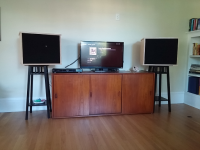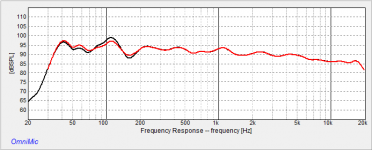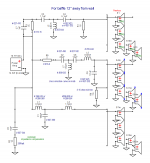Yes, someone messaged me that PE showed them 'in-stock' now, but I hadn't been able to find it there. Found it via the google as you suggested, thanks. A search at PE on '264-1420' (their stock number) also finds it, it turns out, who know what is going on (it's still listed as 'Clearance'). I have enough for my two builds, but need something that will be available long term for a published design to make sense. I have a number of designs now that can be found online that feature NoLongerAvailable drivers, I specifically intended this one to not have that 'feature'!
I played the shelf ported version this afternoon. Has the Synergy sound. It certainly has more bass, so there's that. The bass sounds different, but I was in a different room, too. The sealed version might be more neutral. It was more unique hearing the point-source-with-directivity (PSWD?) effect coming from the small cabinets, too (other Synergy's I've heard have been biggies). I have to bring the new shelf-porteds up to the living room and them compare.
And to also do the FIR phase EQ, and compare then. Some claim the difference between sealed and ported sound is the group delay.... well, I can take care of that easily with the miniDSP. Should be an interesting experiment 🙂
I played the shelf ported version this afternoon. Has the Synergy sound. It certainly has more bass, so there's that. The bass sounds different, but I was in a different room, too. The sealed version might be more neutral. It was more unique hearing the point-source-with-directivity (PSWD?) effect coming from the small cabinets, too (other Synergy's I've heard have been biggies). I have to bring the new shelf-porteds up to the living room and them compare.
And to also do the FIR phase EQ, and compare then. Some claim the difference between sealed and ported sound is the group delay.... well, I can take care of that easily with the miniDSP. Should be an interesting experiment 🙂
The extending furniture gliders support the magnets of the driver and woofers?
The gliders couple the backs of the drivers (and so, the baffle) to the other panels via the bracing. That's the idea, anyway. Because the inside behind the baffle is basically filled up with drivers and a horn, there's no place to put any panel braces to it. And I thought (but don't really know) that dissipating some of the vibrations in the felt pad might be better than just redistributing them around the cabinet. Squashing felt between drivers and the back cabinet and stiffeners seemed to work on the sealed boxes.
Thanks Bwaslo for your inputs... I have to work a little about the phase concept to understand more about my hobby 🙂
Eldam,
It's not too complicated. Basically when you are crossing between two speakers, the relative phases of the signal coming from each over the frequencies where they both play determines how much output you get when they add together. When they're exactly in-phase 0 degrees you get the most because they sum together by amplitude (might or might not be what is needed for flat response though). In quadrature (90 degrees) you get only a little more than either driver by itself, and as they approach 180 degrees, their outputs begin to cancel so you get less than from one of the drivers alone, which could be ok with a point-source, if that relative phase helps flatten the response -- though it makes drivers work harder than they need to, so best to avoid that. In a non-point-source, the relative phasing will also affect which way the lobes from the speaker point into the room, with a point-source that isn't an issue.
Last edited:
😕😕😕Some claim the difference between sealed and ported sound is the group delay.... well, I can take care of that easily with the miniDSP. Should be an interesting experiment 🙂
How can you correct a mechanical issue ?
😕😕😕
How can you correct a mechanical issue ?
In a vented box the rear wave is about 180 degrees out of phase.
Fir filters can correct phase.
How does bass reflex work ?
We know that the whole point of an enclosure is to separate the waves created by the back of the speaker from the ones generated by the front. Because these waves are out of phase, when they meet, they will cancel each other out. You can make an analogy with math, positive numbers are in phase and negative numbers are out of phase. And just like in math : – x + x = 0.
But wait a minute! If I use a port, doesn’t that mean that the back waves travel through the port and reach the front waves and achieve cancellation ? That is a very good question, because at first glance, that looks like a valid theory. In reality, something else happens. The port acts like a Helmholtz resonator, and back waves reverse phase and come out the port in phase with the front waves. Because of this, not only it does not cancel the front waves, it reinforces them ( +x +x = 2x ). This is where the +3 db efficiency comes from. This effect only happens when the resonance frequency of the port is reached. Above this point (higher frequencies), the mass of air inside the port is too great to respond to the speaker movement, and it acts like a perfectly sealed enclosure. Below this point, the port acts just like a hole in a sealed box . The back waves do not reverse phase and come out of the port, only to cancel the waves generated by the front of the speaker. That is why the bass reflex speaker has such a steep roll-off (24 db / octave) below the resonance frequency point.
We know that the whole point of an enclosure is to separate the waves created by the back of the speaker from the ones generated by the front. Because these waves are out of phase, when they meet, they will cancel each other out. You can make an analogy with math, positive numbers are in phase and negative numbers are out of phase. And just like in math : – x + x = 0.
But wait a minute! If I use a port, doesn’t that mean that the back waves travel through the port and reach the front waves and achieve cancellation ? That is a very good question, because at first glance, that looks like a valid theory. In reality, something else happens. The port acts like a Helmholtz resonator, and back waves reverse phase and come out the port in phase with the front waves. Because of this, not only it does not cancel the front waves, it reinforces them ( +x +x = 2x ). This is where the +3 db efficiency comes from. This effect only happens when the resonance frequency of the port is reached. Above this point (higher frequencies), the mass of air inside the port is too great to respond to the speaker movement, and it acts like a perfectly sealed enclosure. Below this point, the port acts just like a hole in a sealed box . The back waves do not reverse phase and come out of the port, only to cancel the waves generated by the front of the speaker. That is why the bass reflex speaker has such a steep roll-off (24 db / octave) below the resonance frequency point.
Put inside the equation also:
The rigidity of the enclosure and its"soundproofness".
The cone itself that is just a subtle membrane...
The rigidity of the enclosure and its"soundproofness".
The cone itself that is just a subtle membrane...
Actually it's not that equal amounts of sound are created on both sides of the cone and that ported uses both of them. It's more about loading on the cone, as this determines how much sound power is taken from the cone. Around the tuning frequency, the cone is strongly loaded and therefore has little displacement. Because the cone almost doesn't move, there is little sound generated at the front side of the cone. (Yet the system is louder than a closed box. If you want a full explanation, be careful when searching as many explanations are plain wrong.)How does bass reflex work ?
We know that the whole point of an enclosure is to separate the waves created by the back of the speaker from the ones generated by the front. Because these waves are out of phase, when they meet, they will cancel each other out.
First part is true, small correction is that the port rotates phase with 90 degrees instead of 180 (only at tuning frequency).[...] The port acts like a Helmholtz resonator, and back waves reverse phase and come out the port in phase with the front waves.
Last edited:
😕😕😕
How can you correct a mechanical issue ?
Delay is also a signal issue. If you change the delays/phase response of the signal going into the reflex speaker, you change the same at the output and can correct for the delay and phase effects caused by the signal paths and resonances to make them the same as with a sealed or other types. That's what an FIR filter can do, it can change the phase vs. frequency independently of the amplitude. (FIR can also change the amplitude response independently if you wanted).
At frequencies much below the port resonance, though, the port output starts cancelling the cone outputs, so you start running out of dynamic range -- you could make the magnitude response flat down to some point, but it would get overdriven too easily. But you can still change the phase response at will.
Last edited:
Put inside the equation also:
The rigidity of the enclosure and its"soundproofness".
The cone itself that is just a subtle membrane...
Both of which are also factors with a sealed speaker as well. The "soundproofness" of the box has an advantage with sealed, though, since higher frequencies in the backwave can come out of a port (a good reason for steeper crossovers with ported speakers). And you can't stuff a ported box with absorbent nearly as much as with a sealed box, at least not without killing the resonance you are trying to use with the ported box.
Oh Man !
I like it a lot ! Both the phrase and the photograph ! And I like the photograph a lot more ..... or maybe equaly! I can't decide !
Tripod>quadripod "piedstal" is not so pretty but cabinets are .... just simply elegant !🙂.... defintly no "fractal"... so : so human !
I like it a lot ! Both the phrase and the photograph ! And I like the photograph a lot more ..... or maybe equaly! I can't decide !
Tripod>quadripod "piedstal" is not so pretty but cabinets are .... just simply elegant !🙂.... defintly no "fractal"... so : so human !
Thanks, Eldam! I'm pretty sure the wife likes the smaller ones better (big surprise, right?). But that's ok, the not-as-small ones sound better in my downstairs listening area, there's a room peak upstairs that I could EQ out, but haven't got that far yet.
Don't like the stands? (They're IKEA plant stands...). My wife picked them out, so I'll go with what she wants. I wanted to make some natural oak stands to match the cabinets, but will probably only do that for the downstairs system.
(Yes, I'm planning to try to sell the older big CoSynes horn speakers. I think the Small Syns sound better and fit better as well. Of course, that will only happen if anyone near enough to be able to transport them home wants them!).
Don't like the stands? (They're IKEA plant stands...). My wife picked them out, so I'll go with what she wants. I wanted to make some natural oak stands to match the cabinets, but will probably only do that for the downstairs system.
(Yes, I'm planning to try to sell the older big CoSynes horn speakers. I think the Small Syns sound better and fit better as well. Of course, that will only happen if anyone near enough to be able to transport them home wants them!).
WIfe just loved the one on the photograph without knowing the size 😉*
* : you know since the Focal Grand Utopia, she are not more "surprised" (focused) on the size... but the legs are still important !
* : you know since the Focal Grand Utopia, she are not more "surprised" (focused) on the size... but the legs are still important !
Last edited:
.... And she, I, We, ... defintly believe this minimalist shape is elegant and can be embeded in a western european living room.
Great pics Bill!
The compression drivers and Celestions came in today. I was able to source some high grade plywood as well - should have that next week (waiting on a friend with a truck). Looking forward to starting the build!
I gather you haven't been able to measure the ported box yet. Do you feel the porting and volume increase has affected midrange performance? The sealed boxes sure would fit better in my current living room, so I'm almost leaning that way... decisions decisions 😛
-Damian
The compression drivers and Celestions came in today. I was able to source some high grade plywood as well - should have that next week (waiting on a friend with a truck). Looking forward to starting the build!
I gather you haven't been able to measure the ported box yet. Do you feel the porting and volume increase has affected midrange performance? The sealed boxes sure would fit better in my current living room, so I'm almost leaning that way... decisions decisions 😛
-Damian
Hi Damian,
I did a measurement (about 3ft from the baffle) today so I could work up an FIR phase eq for it. Here is the response, with (red) and without (black, no EQ) some mild PEQ I added for in-room bumps. Sorry, I only saved 1/6th octave curves, since that is what I was adjusting the FIR EQ with. The bump near 100Hz is from the speaker itself (interaction between crossover and the driver impedance), the dip is floor bounce.
I'm very happy with the sound, though it makes me even more bummed about the tweeter being discontinued. I haven't gone outside to do polar measurements, but the on-axis is very close to the same as the sealed version, as is the sound (except for more powerful sounding bass). I did tweak the crossover a little (the same should probably be done on the sealed version). C3 and R1 change a little. Not sure if it can be heard, but the midrange gets a little flatter, at least with the particular instances of drivers I used.
I did a measurement (about 3ft from the baffle) today so I could work up an FIR phase eq for it. Here is the response, with (red) and without (black, no EQ) some mild PEQ I added for in-room bumps. Sorry, I only saved 1/6th octave curves, since that is what I was adjusting the FIR EQ with. The bump near 100Hz is from the speaker itself (interaction between crossover and the driver impedance), the dip is floor bounce.
I'm very happy with the sound, though it makes me even more bummed about the tweeter being discontinued. I haven't gone outside to do polar measurements, but the on-axis is very close to the same as the sealed version, as is the sound (except for more powerful sounding bass). I did tweak the crossover a little (the same should probably be done on the sealed version). C3 and R1 change a little. Not sure if it can be heard, but the midrange gets a little flatter, at least with the particular instances of drivers I used.
Attachments
If you're going to use a DSP EQ (so you can apply a Linkwitz Transform), then I'd just go ahead with the sealed version -- I can give you a configuration file for the MiniDSP 2x4HD (including FIR EQ for linear phase on either the sealed or the shelf ported).
If you will use them with subs, then certainly go with the sealed, easier to build too. Though you'll have to do the arithmetic to determine the board cuts on that one for now.
If you will use them with subs, then certainly go with the sealed, easier to build too. Though you'll have to do the arithmetic to determine the board cuts on that one for now.
Looking good bwaslo! Looks wise I particularly like the proportions of the sealed box (looks golden ratio).
Any chance you can provide CSD plots of the compression driver and phase and group delay plots of the completed speaker before and after implementing the FIR filter?
Any chance you can provide CSD plots of the compression driver and phase and group delay plots of the completed speaker before and after implementing the FIR filter?
- Home
- Loudspeakers
- Multi-Way
- Small Syns




